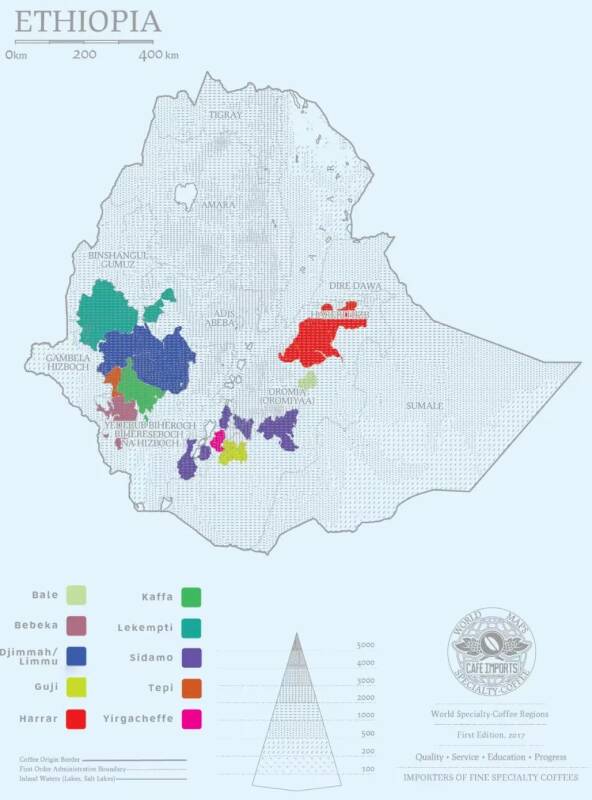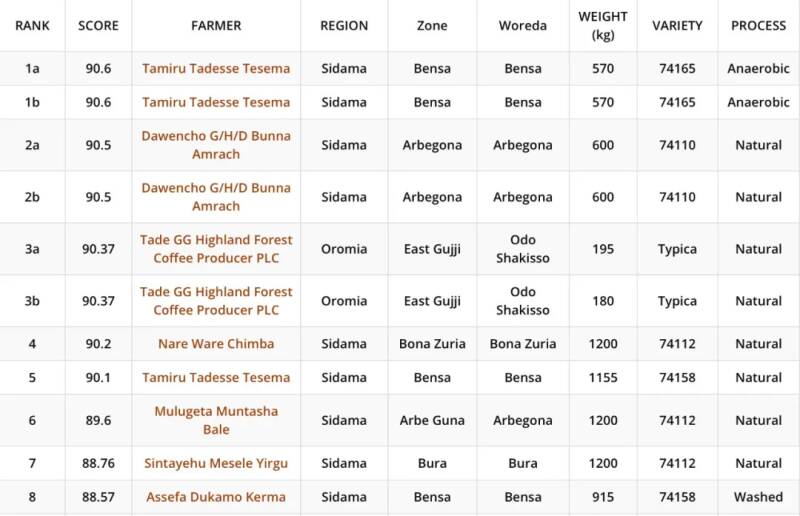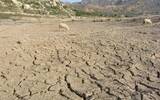Ethiopia| Alo coffee beans in Bansa area of Sidamo region
Ethiopia is a mecca for coffee lovers. It is the birthplace of coffee and is now the largest Arabica coffee producer in Africa.
There are mainly mountain plateaus in Ethiopia, most of which belong to the Ethiopian plateau, accounting for 2 to 3 of the whole country. The East African Rift Valley runs through the whole territory, with an average elevation of nearly 3000 meters, while the average elevation of Ethiopia is 2450 meters. Such a high altitude makes the annual average temperature in Ethiopia is 16 ℃, which is roughly divided into dry season and rainy season, with annual rainfall of 1237 mm. The country is rich in natural resources, rich in water resources, high-altitude mountains and more than 50 volcanoes, which make the country an ideal area for coffee cultivation.

Ethiopia has several coffee producing areas, including Sidamo, Harald, Kaffa, Limmu, Lekempti, Tepi, Bebeka and Bale. Among them, several producing areas such as Yega Xuefei, Guji, Sidamo and Bebeca are relatively well-known.
In recent years, the Bensa area of Sidamo has gradually come into view, and recently the Alo coffee bean fire in Bansa area, a number of coffee roasters at home and abroad have put Alo coffee beans on the shelves.
It is understood that the production area is famous for its COE in 2021. Of the 30 beans awarded by COE that year, 16 were from the Sidamo region, while 6 of the 16 were from the Bansha area.
It is worth noting that the winner of Ethiopia's 2021 COE was Tamiru Tadesse Tesema, with a high score of 90.6, also from the Bansa region of Sidamo.

Ethiopia COE results in 2021
Tamiru Tadesse, who runs a coffee supplier and has been in the coffee-related business for the past decade, works with about 200 local farmers in Banza who own about 80 hectares of land to grow coffee and produce about 182000 kilograms of coffee cherries a year, while he is responsible for processing and exporting.
Tamiru Tadesse
A long time ago, there were farmers growing coffee in the village of Alo. Coffee trees were planted in areas above 2400 meters above sea level. After several years of cultivation, these coffee trees produced very small coffee cherries, but because local coffee traders did not like small coffee beans, they did not find a suitable buyer.
In 2020, Tamiru Tadesse came to Alo village, tasted these small coffee beans, felt that these small coffee beans had great potential in flavor and quality, and thought that they were seriously undervalued by the market.
A processing station was set up in Alo village to collect and process coffee beans grown by coffee farmers in Alo village, and to provide them with professional training in planting knowledge. At present, coffee beans produced in nearby villages of Elto and Gute will be taken care of. In addition to native seeds or Heirloom, digital varieties opened by Jimma Agricultural Research Center (JARC), such as 74158 and 74165, will be planted in this area.
Important Notice :
前街咖啡 FrontStreet Coffee has moved to new addredd:
FrontStreet Coffee Address: 315,Donghua East Road,GuangZhou
Tel:020 38364473
- Prev

Break through $4000! Coffee futures prices rise crazily again
In April, coffee futures prices soared wildly, and Robusta coffee futures hit a record high of US$4399/ton. The reason why prices are high is due to the reduction in production caused by dry weather in Vietnam. According to the Vietnam Coffee and Cocoa Association report, coffee production and exports in 2024/25
- Next

Mstand Coffee Order Mini programs were smashed for a game console!
▲ Click to pay attention| Daily Boutique Coffee Culture Magazine Coffee Workshop Today is the last day of May, which means that the happy Children's Day is not far away. This festival belonging to children is usually an interactive day for brands such as KFC and McDonald's that are related to children's preferences. But he is keen to launch various surrounding M
Related
- Caught off guard! Starbucks '15-year-old store quietly closes!
- Naixue Drink drank a stone and claimed a claim was retaliated by the merchant?!
- What is the difference between a cake filter cup and a V60 conical filter cup? What are the advantages and disadvantages of the flat-bottomed filter cup brewing solution?
- What is the difference between fine coffee powder and medium coarse coffee powder? Do I need to sift out the fine coffee powder for making coffee by hand?
- Why does hot American coffee taste bitter? Difference in proportional concentration between hot American and ice American
- Is espresso stored overnight in the refrigerator harmful to your body? Is frozen coffee better than freshly ground coffee?
- What parameters and proportions of water temperature should be used to grind and brew fresh coffee beans? Why can't I drink freshly roasted coffee right away?
- Customers have "changed" Manner's new products! Shop assistant: Please don't mess around!
- Remove sockets in customer areas at Starbucks stores?! Netizen: I won't go if I really tear it down
- What is the difference between the taste steps of sun-dried coffee and washed coffee? Why is sun-cured coffee sweeter and washed coffee sour?

